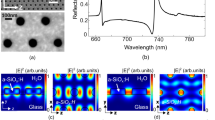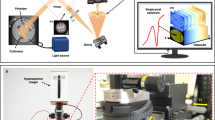Abstract
Metasurfaces based on resonant subwavelength photonic structures enable novel ways of wavefront control and light focusing, underpinning a new generation of flat-optics devices1. Recently emerged all-dielectric asymmetric metasurfaces, composed of arrays of metaunits with broken in-plane inversion symmetry2,3,4,5,6,7, exhibit high-quality resonances originating from the intriguing physics of bound states in the continuum. Here, we combine dielectric metasurfaces and hyperspectral imaging to develop an ultrasensitive label-free analytical platform for biosensing. Our technique can acquire spatially resolved spectra from millions of image pixels and use smart data-processing tools to extract high-throughput digital sensing information at the unprecedented level of less than three molecules per μm2. We further show spectral data retrieval from a single image without using spectrometers, enabled by our unique sensor design, paving the way for portable diagnostic applications. This combination of nanophotonics and imaging optics extends the capabilities of dielectric metasurfaces to analyse biological entities and atomic-layer-thick two-dimensional materials over large areas.
This is a preview of subscription content, access via your institution
Access options
Access Nature and 54 other Nature Portfolio journals
Get Nature+, our best-value online-access subscription
$29.99 / 30 days
cancel any time
Subscribe to this journal
Receive 12 print issues and online access
$209.00 per year
only $17.42 per issue
Buy this article
- Purchase on Springer Link
- Instant access to full article PDF
Prices may be subject to local taxes which are calculated during checkout





Similar content being viewed by others
Data availability
The data that support the plots within this paper and other findings of this study are available from the corresponding author upon reasonable request.
Code availability
The custom codes used in this study are available from the corresponding author upon reasonable request.
References
Capasso, F. The future and promise of flat optics: a personal perspective. Nanophotonics 7, 953–957 (2018).
Campione, S. et al. Broken symmetry dielectric resonators for high quality factor fano metasurfaces. ACS Photon 3, 2362–2367 (2016).
Liu, M., Powell, D. A., Guo, R., Shadrivov, I. V. & Kivshar, Y. S. Polarization-induced chirality in metamaterials via optomechanical interaction. Adv. Opt. Mater. 5, 1600760 (2017).
Tuz, V. R. et al. High-quality trapped modes in all-dielectric metamaterials. Opt. Express 26, 2905–2916 (2018).
Tittl, A. et al. Imaging-based molecular barcoding with pixelated dielectric metasurfaces. Science 360, 1105–1109 (2018).
Koshelev, K., Lepeshov, S., Liu, M., Bogdanov, A. & Kivshar, Y. Asymmetric metasurfaces with high-Q resonances governed by bound states in the continuum. Phys. Rev. Lett. 121, 193903 (2018).
Koshelev, K., Bogdanov, A. & Kivshar, Y. Meta-optics and bound states in the continuum. Sci. Bull. https://doi.org/10.1016/j.scib.2018.12.003 (2018).
von Neuman, J. & Wigner, E. Uber merkwürdige diskrete Eigenwerte. Uber das Verhalten von Eigenwerten bei adiabatischen Prozessen. Physikalische Zeitschrift 30, 467–470 (1929).
Friedrich, H. & Wintgen, D. Interfering resonances and bound states in the continuum. Phys. Rev. A 32, 3231–3242 (1985).
Marinica, D. C., Borisov, A. G. & Shabanov, S. V. Bound states in the continuum in photonics. Phys. Rev. Lett. 100, 183902 (2008).
Bulgakov, E. N. & Sadreev, A. F. Bound states in the continuum in photonic waveguides inspired by defects. Phys. Rev. B 78, 075105 (2008).
Rybin, M. & Kivshar, Y. Optical physics: supercavity lasing. Nature 541, 164–165 (2017).
Doeleman, H. M., Monticone, F., Den Hollander, W., Alù, A. & Koenderink, A. F. Experimental observation of a polarization vortex at an optical bound state in the continuum. Nat. Photon. 12, 397–401 (2018).
Kruk, S. & Kivshar, Y. Functional meta-optics and nanophotonics governed by Mie resonances. ACS Photon. 4, 2638–2649 (2017).
Kuznetsov, A. I., Miroshnichenko, A. E., Brongersma, M. L., Kivshar, Y. S. & Luk’yanchuk, B. Optically resonant dielectric nanostructures. Science 354, aag2472 (2016).
Fabrizio, E. D. et al. Roadmap on biosensing and photonics with advanced nano-optical methods. J. Opt. 18, 063003 (2016).
Bontempi, N. et al. Highly sensitive biosensors based on all-dielectric nanoresonators. Nanoscale 9, 4972–4980 (2017).
Yavas, O., Svedendahl, M., Dobosz, P., Sanz, V. & Quidant, R. On-a-chip biosensing based on all-dielectric nanoresonators. Nano Lett. 17, 4421–4426 (2017).
Lee, S. H., Lindquist, N. C., Wittenberg, N. J., Jordan, L. R. & Oh, S.-H. Real-time full-spectral imaging and affinity measurements from 50 microfluidic channels using nanohole surface plasmon resonance. Lab Chip 12, 3882–3890 (2012).
Ballard, Z. S. et al. Computational sensing using low-cost and mobile plasmonic readers designed by machine learning. ACS Nano 11, 2266–2274 (2017).
Tsukruk, V. V., Luzinov, I. & Julthongpiput, D. Sticky molecular surfaces: epoxysilane self-assembled monolayers. Langmuir 15, 3029–3032 (1999).
Walt, D. R. Optical methods for single molecule detection and analysis. Anal. Chem. 85, 1258–1263 (2013).
Bradley, A. P. The use of the area under the ROC curve in the evaluation of machine learning algorithms. Pattern Recognit. 30, 1145–1159 (1997).
Karst, J., Strohfeldt, N., Schäferling, M., Giessen, H. & Hentschel, M. Single plasmonic oligomer chiral spectroscopy. Adv. Opt. Mater. 6, 1800087 (2018).
Ferrari, A. C. & Basko, D. M. Raman spectroscopy as a versatile tool for studying the properties of graphene. Nat. Nanotechnol. 8, 235–246 (2013).
Ni, Z. H. et al. Probing charged impurities in suspended graphene using Raman spectroscopy. ACS Nano 3, 569–574 (2009).
Ghamsari, B. G., Tosado, J., Yamamoto, M., Fuhrer, M. S. & Anlage, S. M. Measuring the complex optical conductivity of graphene by Fabry–Pérot reflectance spectroscopy. Sci. Rep. 6, 34166 (2016).
Ogletree, D. F. et al. Revealing optical properties of reduced-dimensionality materials at relevant length scales. Adv. Mater. 27, 5693–5719 (2015).
Acknowledgements
The authors thank D.N. Neshev, A. Avsar and A. Belushkin for fruitful discussions, Y. Pandey and S. Confederat for assistance in preparing the sensor chips, A. Magrez for assistance with Raman spectroscopy, École polytechnique fédérale de Lausanne and Center of MicroNano Technology for nanofabrication. The research leading to these results has received funding from the European Research Council under grant agreement no. 682167 VIBRANT-BIO and the European Union Horizon 2020 Framework Programme for Research and Innovation under grant agreements no. 665667 (call 2015), no. 777714 (NOCTURNO project), no. FETOPEN-737071 (ULTRACHIRAL project) and no. 644956 (RAIS project). Y.K. acknowledges support from the Strategic Fund of the Australian National University.
Author information
Authors and Affiliations
Contributions
F.Y., E.R.A., Y.K. and H.A. conceived and designed the research. F.Y. and Y.J. fabricated the dielectric metasurfaces. F.Y. and E.R.A. carried out optical measurements. F.Y., E.R.A., V.C. and H.A. analysed data. F.Y., Y.J., A.T. and M.L. carried out numerical simulations. All authors contributed to writing the manuscript.
Corresponding author
Ethics declarations
Competing interests
The authors declare no competing interests.
Additional information
Publisher’s note: Springer Nature remains neutral with regard to jurisdictional claims in published maps and institutional affiliations.
Supplementary information
Supplementary Information
Fabrication process and additional discussion, Supplementary Figures 1–12, Supplementary Table 1 and Supplementary References 1–6.
Rights and permissions
About this article
Cite this article
Yesilkoy, F., Arvelo, E.R., Jahani, Y. et al. Ultrasensitive hyperspectral imaging and biodetection enabled by dielectric metasurfaces. Nat. Photonics 13, 390–396 (2019). https://doi.org/10.1038/s41566-019-0394-6
Received:
Accepted:
Published:
Issue Date:
DOI: https://doi.org/10.1038/s41566-019-0394-6
This article is cited by
-
Ultra-wideband terahertz fingerprint enhancement sensing and inversion model supported by single-pixel reconfigurable graphene metasurface
PhotoniX (2024)
-
Metasurface array for single-shot spectroscopic ellipsometry
Light: Science & Applications (2024)
-
Directive giant upconversion by supercritical bound states in the continuum
Nature (2024)
-
Miniaturized spectrometer with intrinsic long-term image memory
Nature Communications (2024)
-
Coincidence imaging for Jones matrix with a deep-learning approach
npj Nanophotonics (2024)



